With over 15 years of experience and millions of global users, Shopify has proven to be the “crown jewel” of the eCommerce world. Square Online Store, on the other hand, is a relative newcomer in the market. The question is whether Square’s fresh appearance and reasonable pricing can compete with Shopify, the eCommerce behemoth. Let’s find out in the following extensive Shopify vs Square comparison.
To answer the question, we will consider the following points:
- Quick overview of the two platforms;
- Detailed comparison of pricing, features, help & support, etc.;
- and which works best for your business.
Wait no further; let’s get the ball rolling!
Shopify vs Square: A Quick Overview
What is Shopify?
Powering 4.7 million stores across over 170 countries, Shopify is undoubtedly one of the largest eCommerce platforms (Source: BuiltWith). With all the top-notch features provided, this all-in-one eCommerce solution can help businesses of all sizes to quickly set up an online store and start selling in no time.

Best of all, the Shopify ecosystem includes everything you need to run your online business. 160+ professionally designed templates and 8000+ diverse apps can help tailor your store to your needs and desires. There’s also smart inventory management, a point-of-sale system, automated sales tax calculation, and so much more to simplify your labor.
Curious about Shopify? Check out our in-depth Shopify review or browse the video below for an intuitive analysis of this eCommerce platform.
What is Square Online?
Being the top payment provider, Square now has everything needed to conquer the world of eCommerce after purchasing Weebly in 2018. Not long afterward, this payment provider introduced Square Online Store, a cloud-based website builder solution for small businesses. Up to now, roughly 250,000 online merchants have been using Square Online services (Source: StoreLeads).

Despite being quite similar to Weebly, Square Online has some cool new features and a free eCommerce plan. Moreover, this solution can seamlessly sync with Square POS (Point-of-Sales) data that automatically updates inventory among your stores. If one currently runs a brick-and-mortar store and wants to get great value for money, look no further than Square Online.
Shopify vs Square: Pros & Cons
While both Shopify and Square come packed with essential eCommerce features, each platform is best for different purposes.
- Square is the platform to beat if you own a small business primarily selling in-person (pop-up shops or brick-and-mortar stores). It features simple yet powerful POS hardware that is specifically tailored to particular types of businesses.
- Shopify, on the other hand, ideally suits larger businesses that mainly sell online to a widespread international audience. The platform comes with comprehensive inventory and shipping capabilities, as well as an epic variety of integrations.
Take a look at the table below for detailed pros and cons of each platform.
Shopify Pros & Cons
[wptb id=68034]
Square Online Pros & Cons
[wptb id=68036]
In the latter part of this Shopify vs Square comparison, we will dive deeper into what Square vs Shopify has in store. Which one is better, Shopify or Square? Stay tuned!
Shopify vs Square: Head-to-Head Comparison
If you don’t have time for the following walls of text, here’s a brief of Shopify vs Square comparison.
[wptb id=46010]
#1. Pricing
Shopify pricing
Shopify provides a 3-day free trial for any user to tour around the platform. There is no cost required, and you can test its amazing features before making a purchase. It’s also possible to prolong the trial period for three more months with only $1/month.
If the trial fulfills your expectations, it’s time to pick a Shopify plan that suits your needs. Currently, the platforms offer three main pricing tiers: Basic Shopify, Shopify, and Advanced Shopify. The subscription cost ranges from $39 to $399 per month, or you can pay on an annual plan and save 25%!
[wptb id=68037]
Shopify also offers Shopify Starter and Shopify Plus for specific business needs in addition to these pricing tiers. At $5/month, Shopify Starter allows you to sell through social platforms or messaging apps with a simplified online store. Meanwhile, Shopify Plus costs from $2000 monthly upwards and is an enterprise eCommerce software designed for high-growth businesses with high annual revenue.
It’s worth noting that unless you use Shopify Payments, all Shopify pricing plans charge a transaction fee. Shopify Payment will eliminate all transaction fees on Basic Shopify, Shopify, and Advanced Shopify plans and reduce the fees of Shopify Starter to 5%.
Apparently, different plans come packed with different features and abilities, yet all of them give out amazing eCommerce features that any merchant would need. Consequently, the platform guarantees to meet the demand of every business, regardless of its size and function.
If you want to know the full costs of running a Shopify store, do not miss out on our thorough Shopify pricing analysis.
Square Pricing
On the other hand, Square lets you through the door without asking for a dime. The Free plan allows you to create an account, access the essential features, and build up an eCommerce website. No cost is required for hosting, SSL certificates, or monthly expenses. Nevertheless, you might have to pay extra money for a custom domain name.
Site statistics, reporting, and other advanced eCommerce features are only included in paid plans: Plus and Premium. Pay $29 monthly for Plus, and you’ll get features specifically designed for restaurants, retailers, or appointment-based businesses. In case you need a specific plan that caters to the complexity of your operations, the Premium plan is at your fingertips.
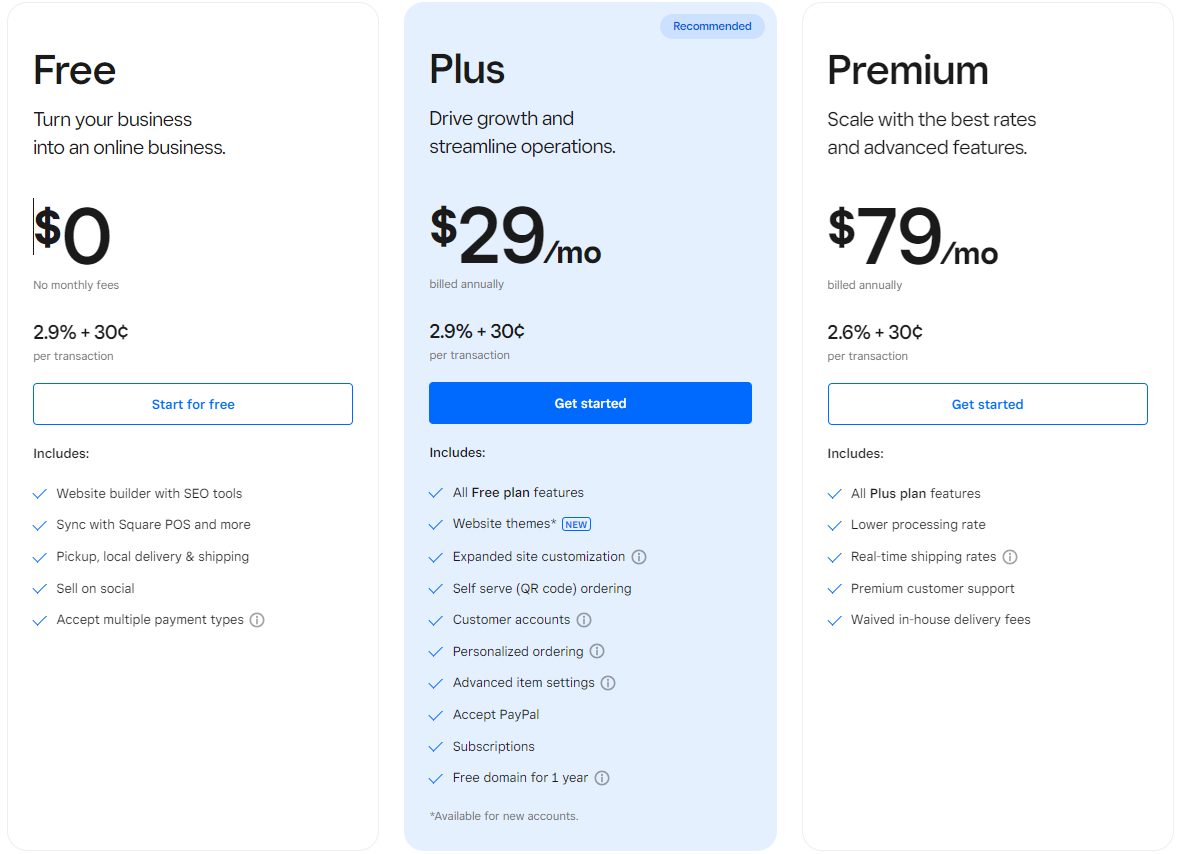
The Verdict
Between Shopify vs Square, the latter clearly offers awesome value for money, making it an ideal option for merchants on tight budgets. The only catch is that the platform charges quite high for transactions (2.9% + $0.30), whereas its rival charges between 0.5% and 2% depending on the plan.
#2. Point-of-Sale System
Both Shopify vs Square are among the best POS systems for retail businesses. But are they the same? Who will win in the battle of Shopify vs Square in terms of point-of-sales? Check out the comparison below to find out!
Shopify POS System
The Shopify POS system comes packed with industry-leading capabilities that enable merchants to manage their products, employees, and inventories easily. With strong point-of-sale software, store owners can add an infinite number of items to their POS. Plus, it’s possible to categorize products automatically using the smart collection function and create product variations depending on their materials and colors.
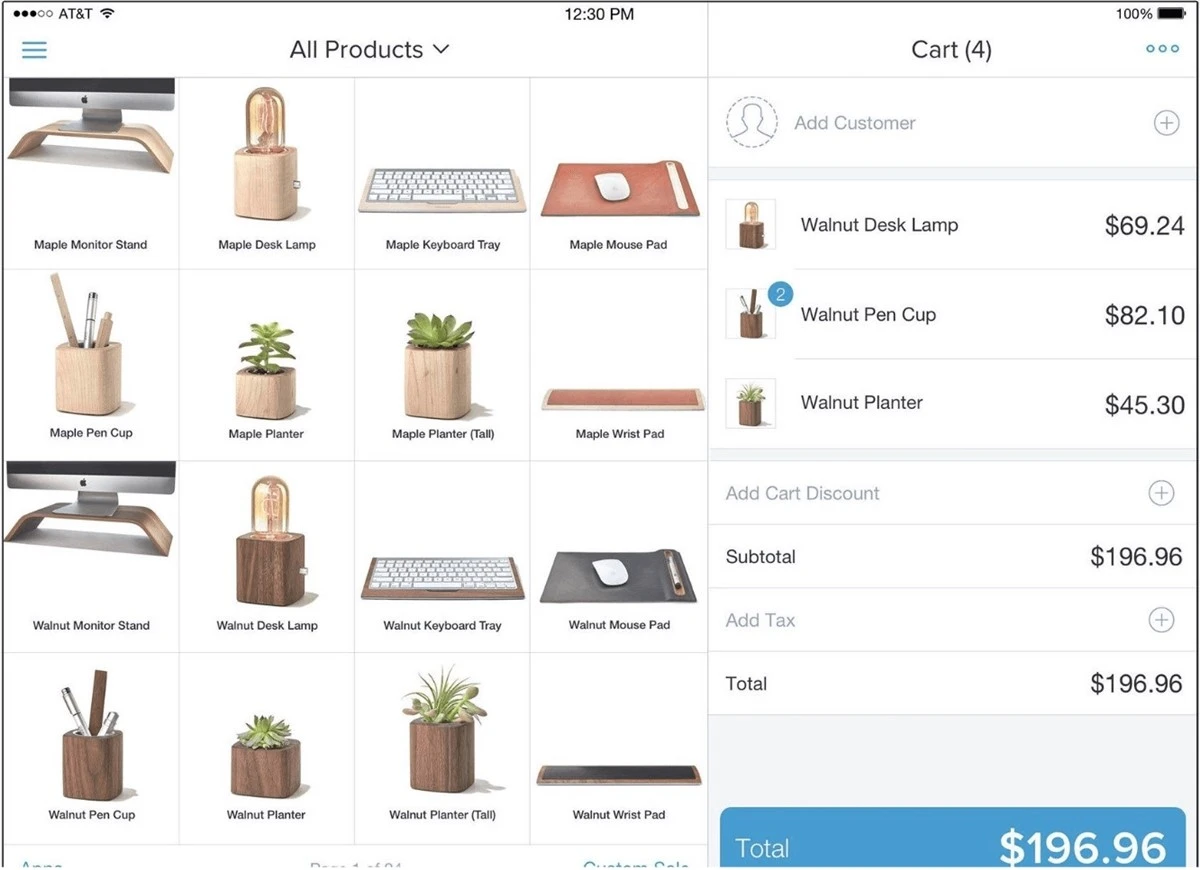
Besides the customer and product management functions, Shopify POS System also offers a top-notch report and analytics tool. This software features an overview report that lets store owners quickly and easily track the overall performance of their stores. With this report, effective selling strategies can be promptly implemented to increase sales.
There are two different pricing tiers available for Shopify POS system: Shopify POS Lite and Shopify POS Pro.
- Shopify POS Lite is ideal for merchants who primarily sell at pops-up, markets and barely need an online store. Instead, you can embed a Buy Button on an existing website or blog to promote your product, all possible without spending a dime. However, Shopify POS Lite is only available on paid plans. Hence, to utilize the features, you should be using at least Shopify Starter, which costs $1/month for the first three months and $5 after that.
- Shopify POS Pro, on the other hand, works best for retail businesses with lots of foot traffic, large inventory catalogs, and multiple staff. You will have access to advanced POS features such as staff, inventory, and customer relation management. Shopify POS Pro will cost an additional $89 per month for each location. Nevertheless, this option is free of charge for all Shopify Plus users.
Square POS System
Being a front-runner in the point-of-sale system market, Square offers four different POS software options. They include one regular point-of-sale app and three other software dedicated to restaurants, retail, and appointments. All of them are packed with powerful functions for inventory tracking (both online and brick-and-mortar stores), customer & order management, and real-time analytics.

While Shopify POS aims at businesses of all sizes, newly established stores highly favor the Square POS system for its flat and transparent pricing. There is no monthly or setup fee for the Square POS system, and you can even get a free card reader as a starter pack. Still, you’ll have to bear a small amount of transaction fee (starting from 2.6% + 10¢) whenever you take payments with Square POS.
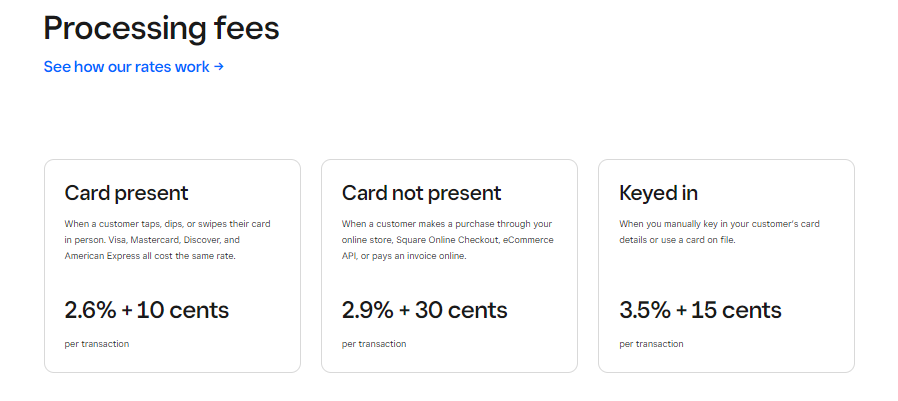
The Verdict
When it comes to point-of-sales, the competition between Shopify vs Square is quite neck-to-neck. Besides the user-friendliness, both systems are packed with top-of-the-class features to sell from anywhere, both online and in person.
Nevertheless, Square POS seems to be a notch better than Shopify since this software is free to install and gives away a free card reader as a starter pack item.
#3. Ease of Use
Shopify Ease of Use
Unlike most eCommerce platforms that struggle to combine powers and ease of use, Shopify boasts amazing features yet a clean and friendly interface. Merchants with little to no technical knowledge can kickstart their online store by following the Get-Started checklist of the platform.

A team at LitExtension, with different technical backgrounds, tests out the platform for hands-on experience for this Shopify comparison. Nobody ever had any trouble creating a Shopify site, and the entire process was a pleasure. As previously stated, Shopify walks you through each step, and everything is laid out logically.
When it comes to initial interactions with Shopify on a day-by-day basis, things are still straightforward. Even if you are tech-novice and might get lost sometimes, you can always find your answer in the Shopify Help Center.
Square Ease of Use
While Shopify takes longer to develop, customize, and configure an online store, Square makes life easier by handling most of the work. All you have to do is enter the name and address of your business, pick the features you want, upload a logo, and choose the color you like best. Your store then shows up with the details you fill in during the process. With just a few more texts and products, your online business is ready to fly off the ground!
On top of that, Square includes a drag-and-drop editor that allows you to access and alter anything immediately. That is something you will never be able to do using Shopify’s section-based editor.
The Verdict
Fortunately, both Shopify vs Square come with an easy-to-use interface. While Shopify provides a full explanation for each step, Square has a drag-and-drop editor that allows merchants to adjust anything easily. With these two platforms, creating an up-and-running eCommerce store in no time is truly possible.
#4. Payment Gateways & Transaction Fees
The payment gateway is a crucial element of your store. Enabling customers to check out with various payment methods ensures a seamless customer experience. Consequently, you can boost your store’s conversion rate, reduce cart abandonment, and thus increase sales volume.
Now, let’s see what Square vs Shopify has to offer in terms of payment methods.
Shopify Payment Gateways & Transaction Fees

Living up to its reputation as the top eCommerce platform, Shopify integrates with an impressive number of 100+ payment processors. Besides the popular choices such as Stripe, PayPal, and 2Checkout, Shopify is one of the leading platforms that accept e-wallets like Google Pay or Apple Pay.
What’s more, Shopify Payments, the in-house payment provider, is available to stores in 23 countries, including the US, UK, Germany… This processor eliminates all transaction fees on every purchase made in your store. More than that, Shopify Payments grants you full access to Shop Pay – an accelerated checkout button dedicated to Shopify stores.
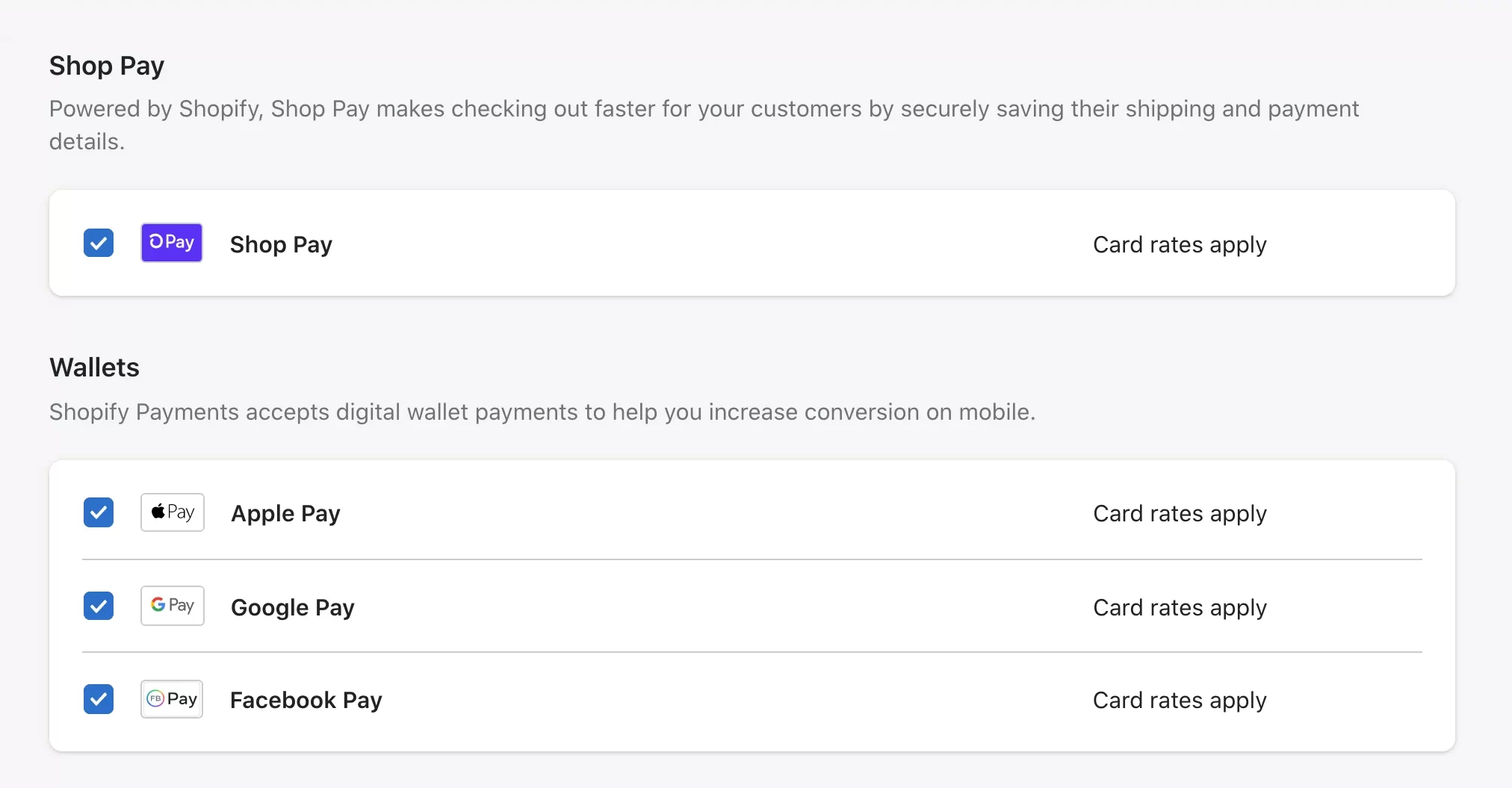
Nonetheless, while you can avoid transaction fees with Shopify Payments, you still need to pay a small amount for credit card processing fees. The price will vary based on the Shopify pricing plan you are in, the order value, and the number of purchases.
Square Payment Gateways
To no surprise, Square Pay is the main payment option of Square Online stores. This processor accepts all major credit cards like Visa, Mastercard, American Express, and Discover.
While the range looks rather small compared to Shopify’s huge choice of payment options, Square Online users are still able to accept payments via Google Pay or Apple Pay. Therefore, it’s not an exaggeration to say Square Online has everything you’ll need to take payment.
Just like Shopify, Square Online also charges a fee for every transaction. You will have to bear 2.9% + $0.30 for each transaction through your online store, while the rate for in-person payment is cheaper at 2.6% + $0.30. However, if your customers make payments through an invoice or the card must be entered manually, the fees are much higher.
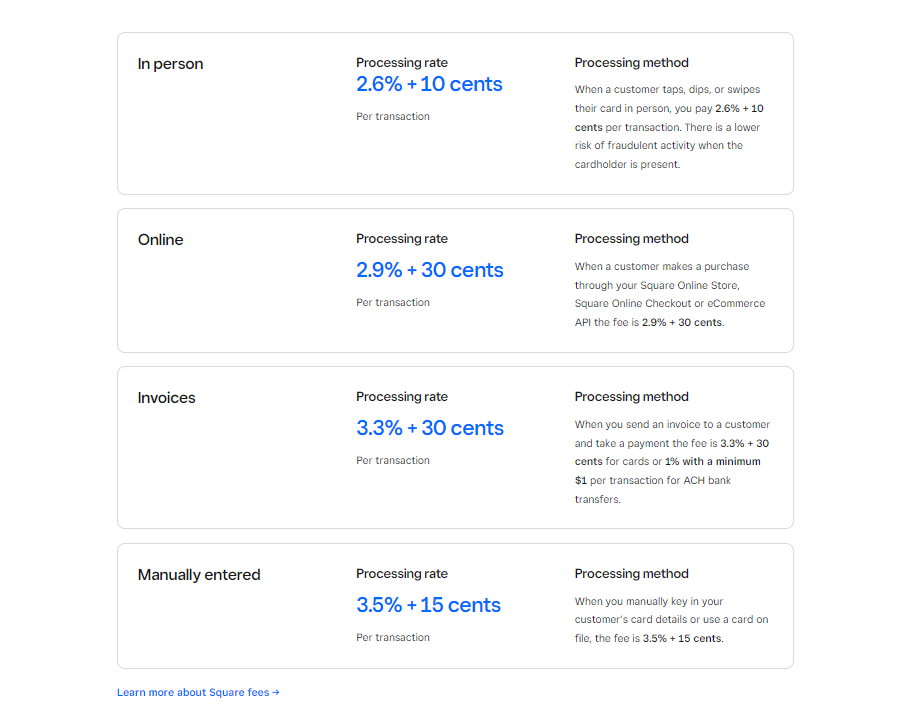
The Verdict
Shopify deserves a strong win in this turn of Square Shopify comparison. The eCommerce giant provides a wider range of payment options, and the transaction fees are more reasonable. On top of that, Shopify offers an option to wipe off transaction fees completely – which is not an option with Square Online.
#5. eCommerce Features
When it comes to creating an online store, eCommerce features must be the #1 thing to consider. While Shopify is renowned as a top eCommerce platform, Square is just a newcomer in the market.
Can Square catch up with its rival in this Shopify vs Square battle? Can Shopify secure its crown against Square? Take a look at the table below to find out!
[wptb id=39016]
The Verdict
Comes packed with all the sales tools needed to maintain and scale up an online business, Shopify wins over its competitor in this round. Whether you are new to the field or looking to grow an already successful business, Shopify has it all to support your long-term selling goals.
Already In Love With Shopify?
If you intend to migrate Square to Shopify, LitExtension offers a great migration service that helps you transfer your data from the current eCommerce platform to a new one accurately, and painlessly with utmost security.
#6. Multichannel Selling
With the explosion of modern commerce in recent years, it’s a bad idea to limit your business to one sales channel alone. Customers are everywhere, from eCommerce sites and social media platforms to online marketplaces. Hence, it’s best to interact with your audience across platforms and increase the odds that you’ll make a sale.
So, what do Shopify and Square Online have to offer when it comes to multichannel selling possibilities? Roll down and find out right below!
Multichannel selling with Shopify
If you ever wonder whether Shopify powers multichannel selling or not, the answer is Yes, definitely! Multichannel Shopify makes it easier for merchants to manage and sell products across all sales channels.
Besides the online store as the main selling channel, Shopify also provides Point of Sales and Buy Buttons, which are already included in every Shopify plan. While Shopify POS allows selling in person, Buy Buttons make it possible for merchants to turn any website or blog into an online store.

On top of that, it’s straightforward to add other selling channels to your existing Shopify store using apps and integrations. There are hundreds of selections for multichannel selling apps at the Shopify App Store, and you can even make specific integrations to your preferred online marketplaces.
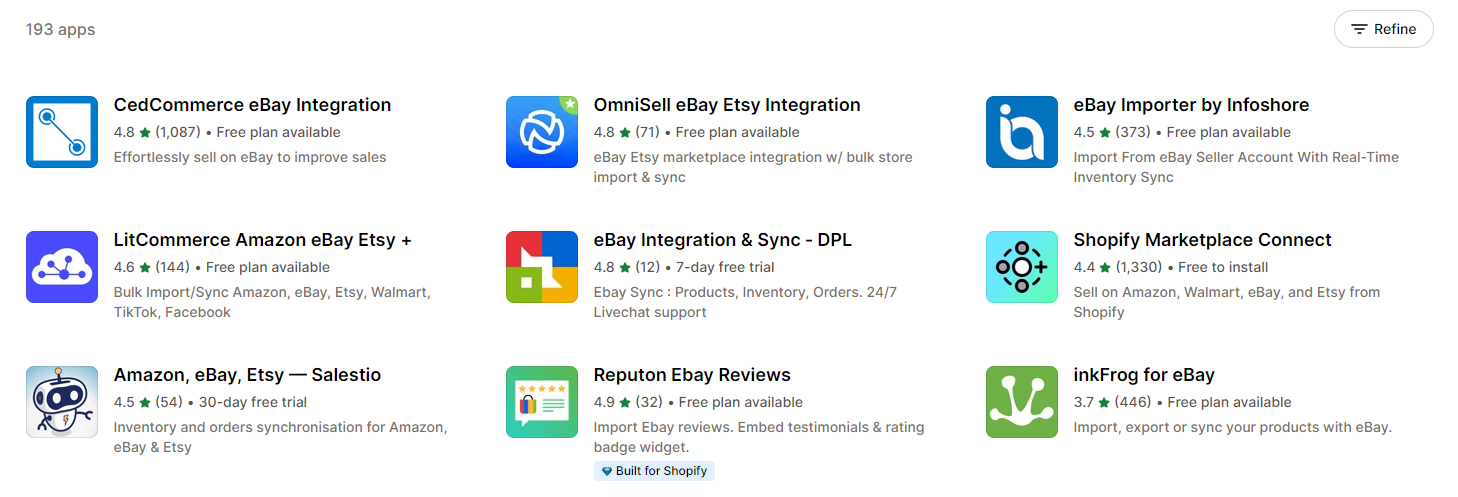
Multichannel selling with Square
Just like its competitor, Square also makes multichannel selling possible. A Square Online user can take advantage of the following channels to increase their selling opportunities.
- Square Online stores, which can be created for free and allow you to take orders from your website.
- A checkout button: You can add it to your existing website, blog, and portfolio so that customers can easily purchase your products or services.
- A payment link: In case you don’t have a website, you are still able to collect payment using a link or QR code generated by Square Online Checkout. Your customers then can settle the payment without leaving the current platform.
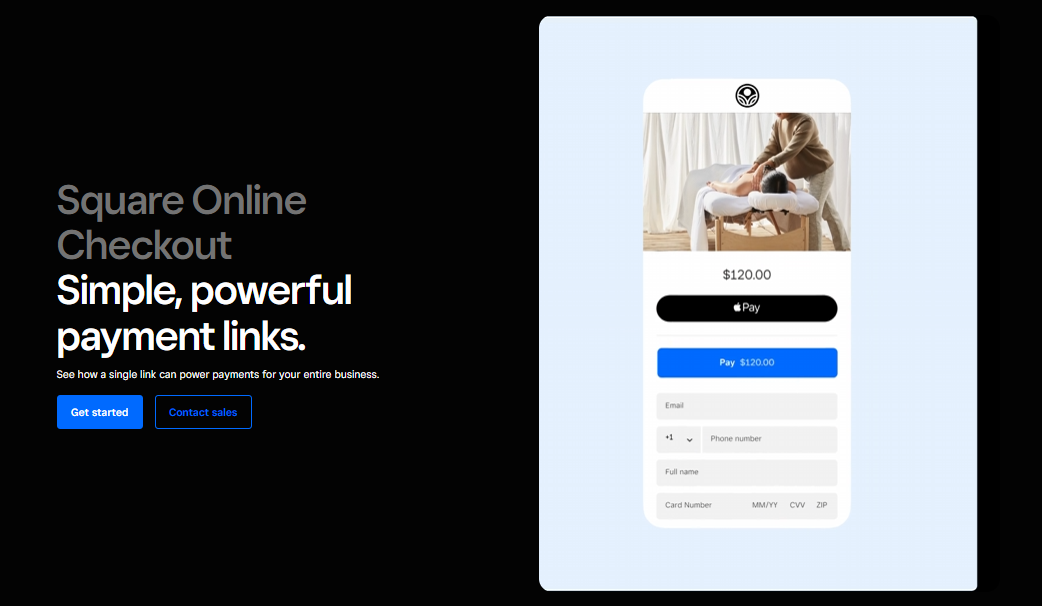
- Last but not least, it’s possible to sell on social media with Square. The ‘Order with Google’ is built in with every Square Online site, allowing your customers to find your business quickly and place online orders. The platform also integrates with Google Product Listings so that shoppers can find your products easily on Google Search, Shopping, or Images.
The Verdict
While both Shopify vs Square offer amazing multichannel selling capabilities, Shopify still stands out with the impressive number of multichannel selling integrations. With Shopify, you can easily run your online businesses across several platforms.
#7. Globalization
Shopify Globalization
Powering millions of online businesses across 170+ countries, it’s not exaggerating to say that globalization is a unique selling point of Shopify. The platform offers an enterprise solution, Shopify Plus, which can grant your business global growth without any limits.
Apart from the amazing benefits included in every Shopify plan, Shopify Plus provides exceptional features that allow you to sell globally with ease.
- Ship anywhere in the world within 1-5 working days and track every order at exclusive discount rates.
- Customers will prepay VAT, duties, and local taxes at checkout. Plus, they can pay their way with local payment methods.
- The product catalog will automatically be filtered based on regional import and carrier restrictions.
- Automatically convert prices to over 130 local currencies.
- Send the right message in every market with language translation and region-specific content.

Square Globalization
Although there is no special version for international selling, Square Online still allows you to ship your physical items from wherever you are, all throughout the globe.
To enable that, Square Online provides an international shipping option for your business. All you need to do is build up an international shipping profile, select the countries you want to ship to, and set the shipping rates.
EasyShip, Shippo, and ShipBob are some special shipping partners of SquareOnline. They all strive to offer you an automated shipping experience, discounted rates with top global couriers, as well as hands-off order fulfillment and warehousing.
The Verdict
Between Shopify vs Square, Shopify definitely makes a better option if you plan on selling globally. Shopify Plus comes with exceptional features that every international seller would need. However, for individuals on tight budgets and who are not yet ready for worldwide markets, Square international shipping is sufficient.
#8. SEO & Marketing Features
Most online businesses heavily rely on SEO (Search Engine Optimization) and marketing to sell their products. These are the make-or-break elements that decide whether your customers see your products before others.
So, how do Shopify vs Square compare in terms of SEO and marketing features? Find out right below!
Shopify SEO & Marketing Features
As luck would have it, Shopify SEO is fairly adequate. You may easily add titles, meta descriptions, and images to your pages. Shopify also allows you to customize URLs and 301 redirects to avoid 404 errors. The site speed is decent, and it’s straightforward to structure your site by categories.
Shopify also offers a blogging feature despite the fact that there is still room to grow. You can start writing right away without help from any third-party app. It’s also possible to add tags and edit titles or keywords. What’s more, Shopify SEO parameters make it easy to optimize your content and increase the chance of showing high on the search result pages.

It’s worth noting that the platform offers excellent email capabilities for sharing information and promoting products. Shopify marketing automation allows you to send multichannel communications to enhance engagement automatically. You can configure the flow using professional pre-built email templates or manually create it your way. What’s best, you can send up to 10,000 emails for free every month.
Square SEO & Marketing Features
When it comes to SEO capabilities; Square Online also allows users to customize page titles and meta descriptions, as well as to add alt text and headings. It’s also straightforward to change page and product URLs despite Square not adding any prefixes to your URLs.
On top of that, the platform comes packed with state-of-the-art email marketing functionality. Square Email Marketing integrates seamlessly with Square POS, which allows you to grow your contact list automatically. No matter what you want to promote: new products, last-minute deals, or seasonal offers, Square can help you tailor suitable content faster using built-in AI technology and create compelling campaigns.

That being said, when running a Square Online store, you will have to create product redirects all by yourself. Moreover, the site speed is quite slow, and there’s no blogging option included with any Square Online plan.
The Verdict
When comparing the two platforms in terms of SEO & marketing features, it’s Shopify to take the crown. Both Shopify vs Square offer basic capabilities, but Shopify has an edge here by providing the blogging function and decent email tools.
#9. Help & Support
Shopify Help & Support
Shopify has a great advantage over its rivals thanks to the top-of-the-class customer support it offers. Shopify’s support team is available 24/7 via phone calls, live chat, and email. Therefore, they are attentive to your concerns and can resolve them as soon as possible.

Besides, Shopify merchants can easily conduct research using the Shopify Help Center or find answers in Shopify’s vibrant eCommerce community.
Square Help & Support
Square also provides support via live chat, phone calls, and email. Nevertheless, please note that Square support is not available 24/7. Consequently, you might not be able to get practical assistance in case of problems and conflicts.
With that being said, Square offers a large knowledge base in its Help Center. You can seek answers using the built-in search query or browse through different categories to find your request.
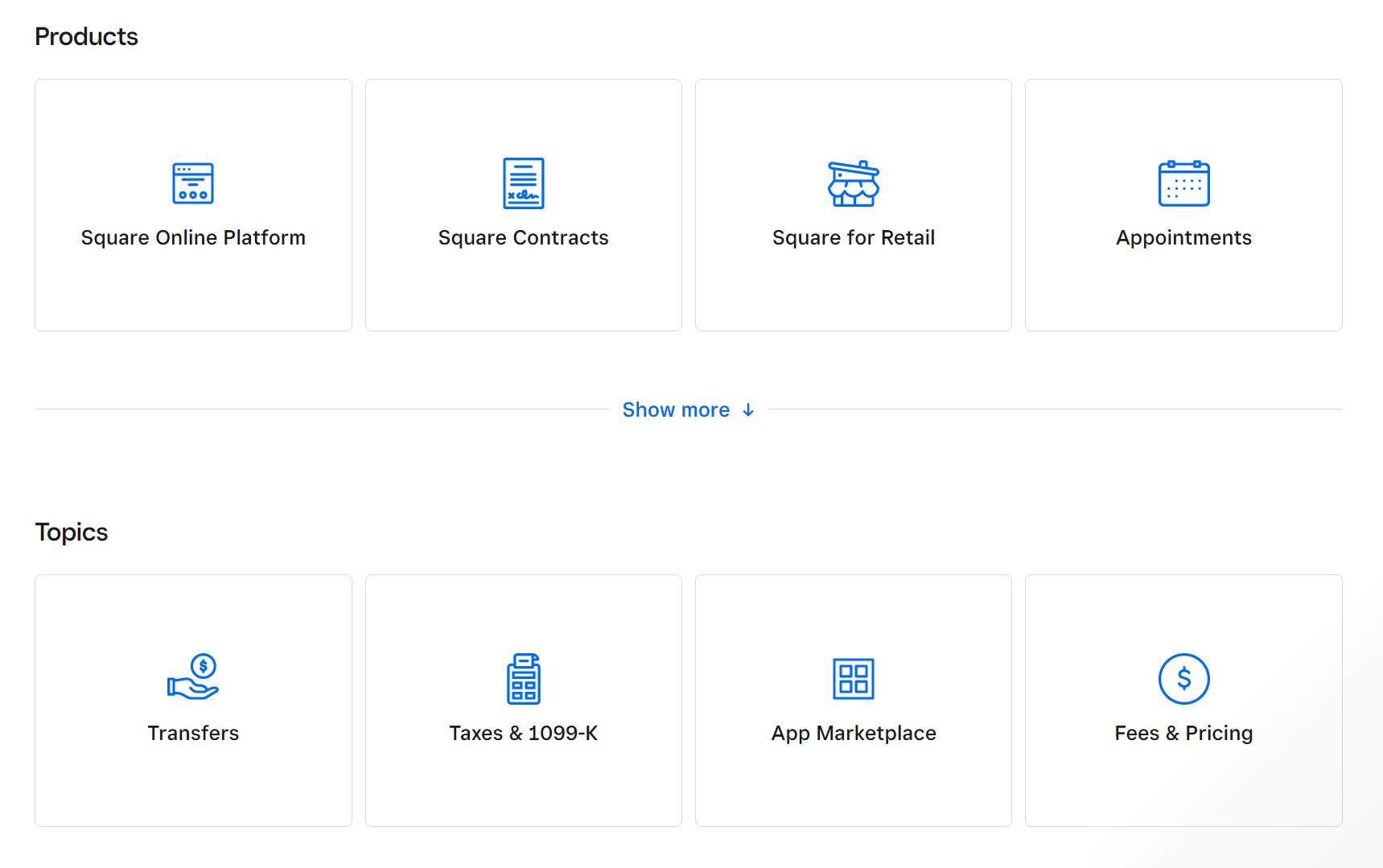
The Verdict
Shopify clearly wins this battle of Shopify vs Square in terms of help and support. This platform provides top-notch customer service that barely any other eCommerce platform offers.
#10. Security
Shopify Security
When running a Shopify store, you don’t need to be concerned about security. As an all-in-one eCommerce solution, Shopify takes care of all security-related issues in the background.
With SSL certification included in every Shopify site, you can rest assured knowing that all data transferred between you and your customers is highly encrypted. The platform also follows security standards for processing credit cards and debit cards, which contributes a lot to increasing the trustworthiness of your store.
What’s more, an internal fraud analysis comes packed with every Shopify plan. There will be fraud indicators, support for third-party fraud apps, and fraud recommendations.
Square Security
With Square being a top payment processor, it’s apparent that Square Online inherits decent security features.
The Secure Card Readers and POS Shopware provide great help to protect customer payment details. While every payment data is well encrypted, the card numbers, magnetic-stripe data, and security codes are never stored on any devices. It ensures that you don’t have to bear the burden of PCI compliance on your Square POS device.
On top of that, every Square account comes with free fraud monitoring and dispute management. There’s also a tool called Risk Manage – a risk management system that takes action on any suspicious card payment.
The Verdict
It’s a draw! Both Shopify vs Square offer acceptable security features. When running online businesses on these platforms, you can enjoy the built-in SSL security, PCI compliance, and the ability to save card details for customers.
Shopify vs Square: Which is Right for Your Business?
Long story short, it’s hard to determine the ultimate winner between Shopify and Square. While Shopify attracts new users with its powerful features to support businesses of all sizes, Square is more friendly to start-ups or entrepreneurs thanks to its affordable pricing plan.
Therefore, it solely relies on customers’ needs when it comes to choosing between Square vs Shopify. Here comes our conclusion:
Go for Shopify if you want to:
- Build an eCommerce store with great scalability and flexibility.
- Benefit from Shopify’s eCommerce integrations.
- Get 24/7 phone support.
- Have a strong POS system available on multiple devices.
Square is the ideal solution for you if:
- You’re on a tight budget and just looking for a platform with adequate features.
- You’re familiar with processing payments through Square.
- You’re selling in-person and want to find an eCommerce platform that features strong POS abilities and helps expand to online commerce easily.
See how Shopify compares with other eCommerce platforms:
Shopify vs Square: FAQs
[sp_easyaccordion id=”47262″]
Shopify vs Square: Wrap-Up
Both Shopify vs Square are amazing eCommerce solutions for your online business. While Shopify comes packaged with a wide range of integrations and decent opportunities to expand your selling channels, Square proves to be a user-friendly platform with strong POS features.
As you keep up with this length, we do hope that the above details have provided you with a clear comparison between Square Online vs Shopify. These may help you pick out the most suitable platform for your business, or you can seek assistance from an eCommerce community of experienced online merchants.
In case you have found your befitting option between these two platforms and plan on migration, LitExtension – the #1 Shopping Cart Migration Expert is delighted to be at your services. With over 10 years of experience and 280,000+ successful migrations, we can help transfer your data seamlessly at the utmost convenience.
Visit our eCommerce Blog for more information about our services, as well as up-to-date knowledge about the eCommerce industry.